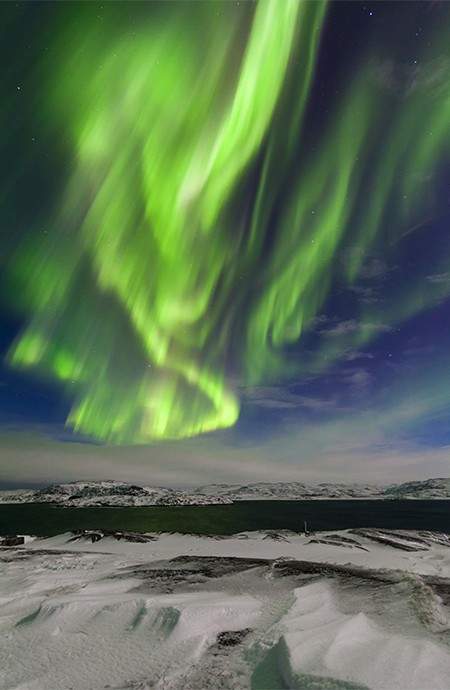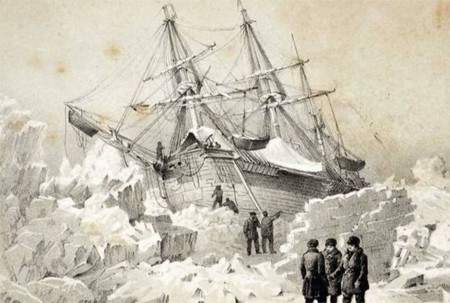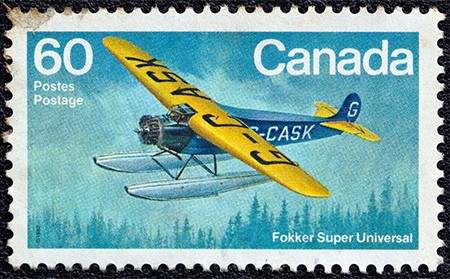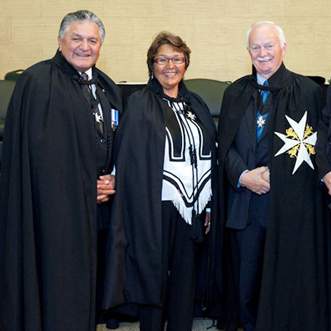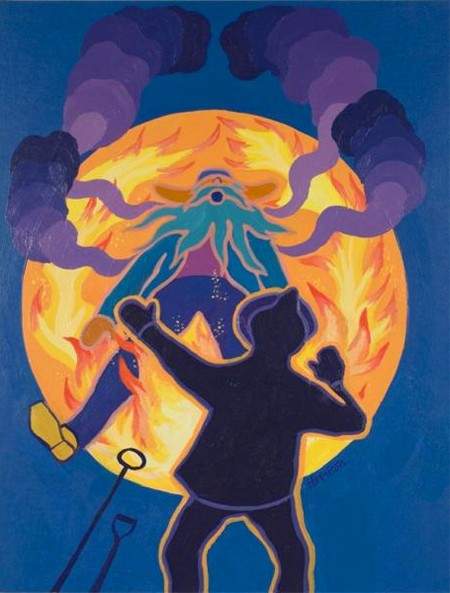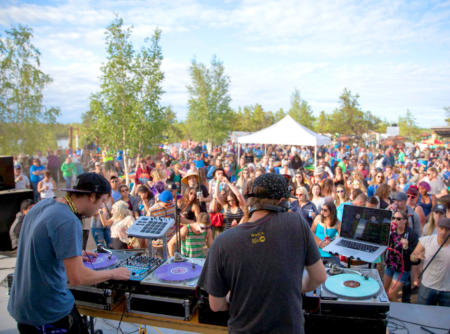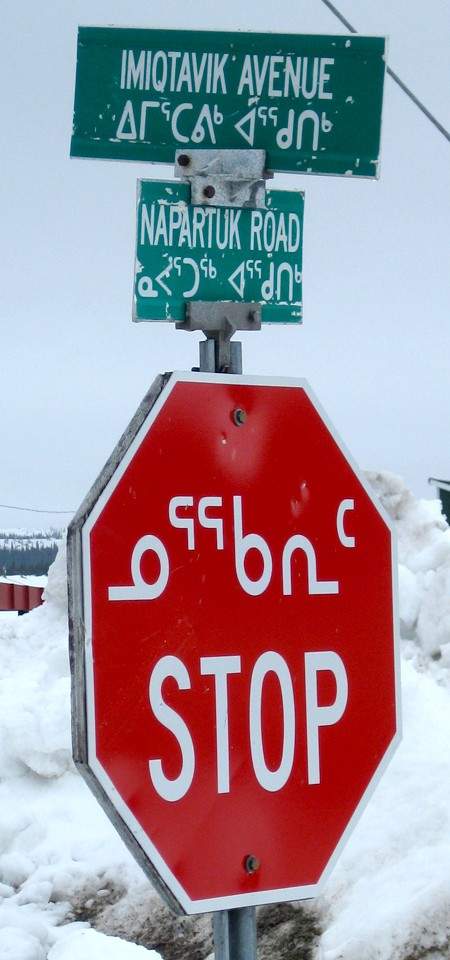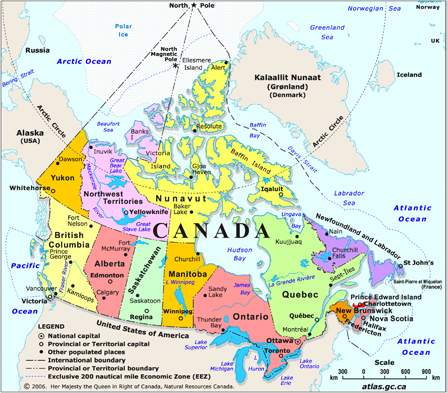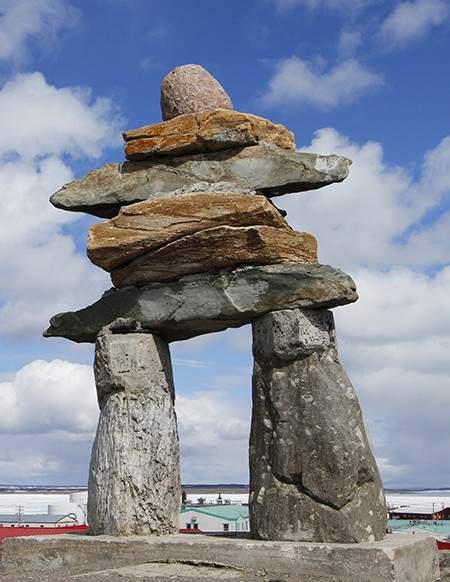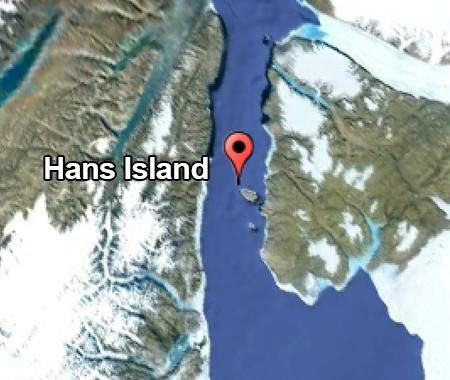No
The Northern Territories
Occupying nearly 40 per cent of the country’s total landmass, the North is an iconic yet mysterious region of Canada. Igloos, icebergs, polar bears, seal hunters and the Northern Lights may be some of Canada’s best-known symbols, but they’re found in a part of the country few will ever visit.
Small in population, mostly weak economically and often unbearable in weather, Canada’s three northern territories are among the most isolated parts of the country, and are easily ignored by all but those who live there. For those tough enough to do so, however, northern living can be a source of great pride — a symbol of man’s ability to overcome some of nature’s harshest terrain in the pursuit of a traditional self-sufficient lifestyle a small number of Canadians have enjoyed for centuries.
Geography
“Northern” Canada encompasses all land above the country’s 60th parallel, which is divided into three territories (from west to east): Yukon, the Northwest Territories and Nunavut. Upwards of 90 per cent of the land in all three is strictly uninhabitable, a barren wasteland of rock, ice and snow, meaning the populated areas are located either in the southern regions, or close to the coast of a lake, river or ocean. Still, “habitable” remains very much in the eye of the beholder. Even in the north’s larger cities, it’s not at all uncommon for winter temperatures to dip below -40˚(C).
Along with the snowy, generally treeless landscapes, Canada’s North is particularly well-known as being the fabled “land of the midnight sun.” Due to its proximity to the Arctic Circle, northern days can entail up to 24 straight hours of sunlight in the summer, but also 24 hours of straight darkness in the winter. In Yellowknife, the capital of the Northwest Territories, for instance, the month of June will get an average of 19 straight hours of sunlight, while in December, the average is about five.
Canada’s most extreme northern region, which is comprised of a series of large islands around the Arctic Circle — the very topmost point of the planet — is home to land that is so frozen, barren, dry and featureless it’s been used as training ground for astronauts. Despite the sub-arctic temperatures, this territory is technically considered a desert by scientists, since there is virtually no moisture or precipitation and few living things can survive.
History of the Canadian North
Unlike the rest of the country, Canada’s North had very low levels of European settlement, as they considered much of the land undesirable. The populations of the Northwest Territories and Nunavut are thus still majority aboriginal, while in Yukon around 23 per cent of the population is aboriginal. Many of these indigenous peoples, known as Inuit, retain cultures and traditions that have remained unchanged for centuries, and in some rural communities, subsistence hunter-gatherer lifestyles are still practiced.
Scandinavian explores from Sweden and Denmark were some of the first Europeans to discover the lands of northern Canada, and though they ultimately chose to make nearby Greenland and Iceland the focus of their arctic empire, many places in northern Canada, such as the Sverdrup Islands or the Prince Gustaf Adolf Sea still bear Scandinavian names. French and British fur traders first migrated to Canada’s North in the mid 1600s, moving westward from their colonies on the Atlantic coast. In 1670, the British made a sweeping claim of ownership of much of the northernmost region of North America, naming the vast territory Rupert’s Land and placing political control in the hands of the British-run Hudson’s Bay Company. Permitted a great deal of independence by London, for two centuries the HBC grew large and wealthy through its cutthroat dominance of the lucrative Canadian fur trade, dotting the northern half of the continent with military bases and commercial trading posts that gradually evolved into modest villages and towns (to this day, many northern cities are still named “Fort” something-or-other).
In 1870, the British decided management of the north was better suited to governments than corporations, and agreed to sell Rupert’s Land to the recently-formed Government of Canada. In the years that followed the land was chopped into several pieces. The southern half, which had a warmer climate, larger population, and better agricultural farmland, became the Prairie provinces of Manitoba (1870), Saskatchewan (1905), and Alberta (1905), while the less populated, less economically desirable northern half was divided into the Northwest Territories (1870) and Yukon (1898), followed by Nunavut (1999) a century later.
The North Today
Today, the combined population of the three northern territories is just under 120,000, a number below the capacity of some sports arenas. The cold climate and general isolation of the region continues to make it an unpopular place to live, work, or visit, which has caused difficulties for those born there.
Though tour guides may attempt to put an upbeat face on Canada’s North by playing up its “serenity” and “vast open spaces,” the North is not generally a happy part of Canada. Virtually all negative statistics — crime, domestic violence, per-capita prison population, drugs, suicide — are vastly higher in the North than anywhere else in Canada, to the point where the region is often excluded from national statistics in order to avoid warping the average. The most common explanation is that the overbearing dullness and economic hopelessness of the region, coupled with hideous weather, provokes chronic depression and anxiety in its residents, as well as a generally nihilistic worldview. Because of their distance from Canada’s major population centres, citizens of the territories also suffer from significant economic problems relating to being cut out of Canada’s major supply routes, including an extremely high cost of living driven by the high price of imported goods, especially food. The fact that two of the three territories have a majority aboriginal population — who are already among Canada’s most disadvantaged demographic – only complicates the situation further, as many young Inuit struggle with questions of purpose, identity and culture in the modern world.
The Government of Canada has become more sensitive to the plight of the North in recent decades, and federal subsidies for northern education, infrastructure, healthcare, social programs, and aboriginal cultural renewal have risen dramatically. Today the territorial governments receive about 70 per cent of their budget revenue from Ottawa. Though the geographic realities of this isolated region will always present an obstacle to economic self-sufficiency, there is some hope that recent discoveries of oil, natural gas, and diamonds could help usher in an era of economic opportunity if managed properly.
Territory vs. Province — what’s the difference?
Historically, the difference between a Canadian “province” and a “territory” was that territories were run by Ottawa, while provinces had democratic self-government. After self-governance was granted to the territories in the 1970s, the only real distinction was that territorial governments could not charge nor collect royalties on their natural resources — only Ottawa could. This was in turn abolished through so-called “devolution” reforms in the 2000s, meaning there are now basically no meaningful differences between a province and a territory beyond name.
Government in Canada’s North
From the time Canada first gained control of Rupert’s Land to about the mid-1970s, there was very little democracy in Canada’s North. They had to share a single member of Parliament (but no senators), and local affairs were managed by Ottawa-appointed commissioners who ruled much like the colonial governors of old. Increasingly unpopular, this state of affairs was massively reformed during the administration of Prime Minister Pierre Trudeau (1919-2000), who gave the territories their own MPs, senators and elected legislatures from which a local prime minister (once called the government leader, now simply the premier) would be chosen, replacing the powers of the commissioner. Though commissioners remain, they’re now powerless figureheads akin to the lieutenant-governors of the provinces, and are usually well-liked local personalities or retired politicians, rather than out-of-territory bureaucrats.
The territorial legislatures of Nunavut and the Northwest Territories are also distinct in that they are strictly non-partisan, meaning all members are elected without political party affiliation. The territorial premier and his cabinet, in turn, are elected by the legislature as a whole, rather than being appointed from the majority party faction in traditional British parliamentary style. This is sometimes known as consensus-style government, since it places greater emphasis on making decisions through the entire legislature, rather than just one faction of it.
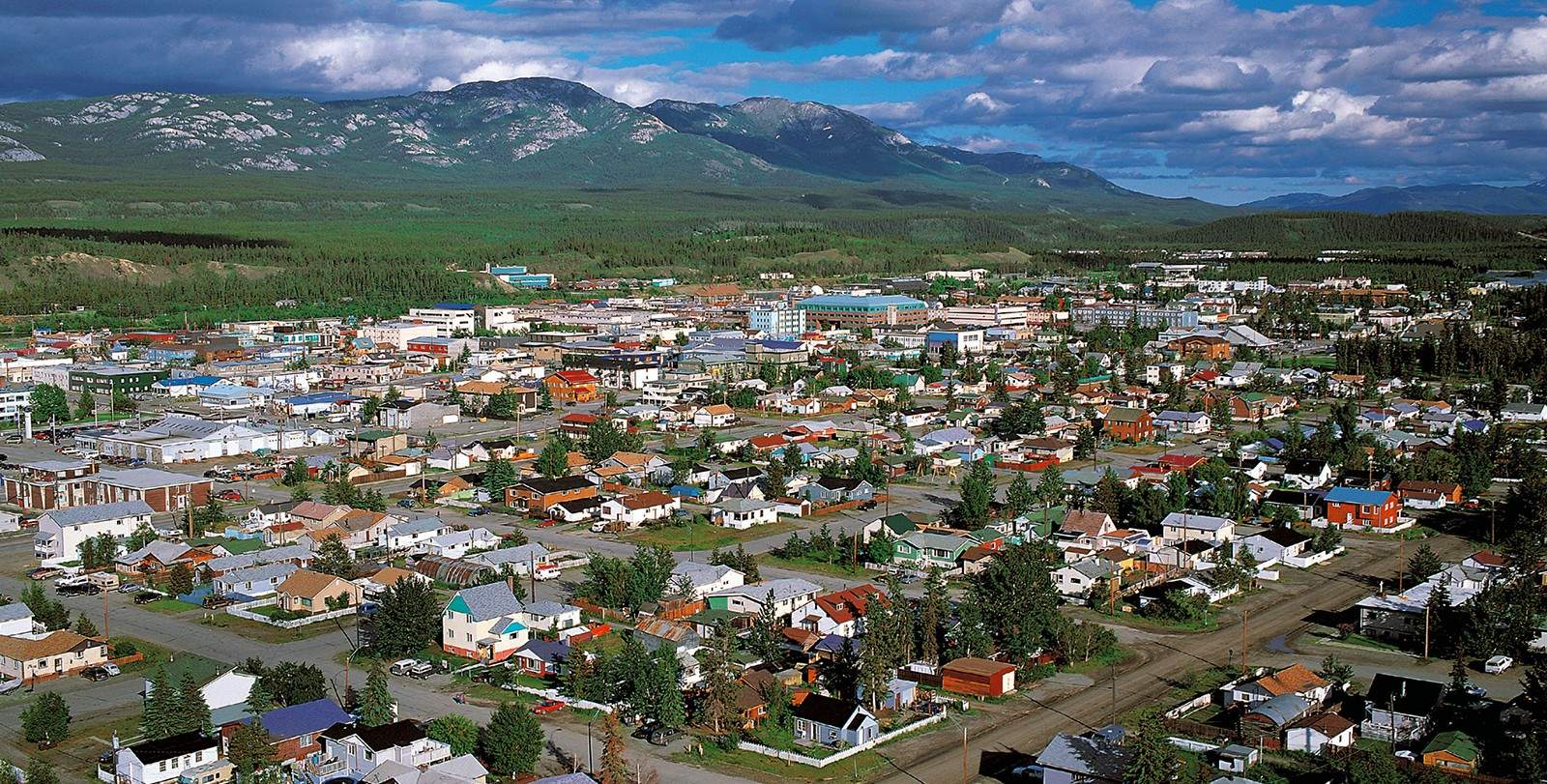
The sprawl of suburban Whitehorse.
Josef Hanus/Shutterstock
Yukon
The history of Yukon (often called “the” Yukon, though that’s no longer the official name) is essentially the history of the gold rush, the territory’s big moment of international fame which it has been living in the shadow of ever since.
Located in the far northwestern corner of Canada, the Yukon district began life as a sleepy fur-trading outpost of the Northwest Territories. Then, in 1897, gold was discovered in the famed Klondike River. Over the next decade, thousands of new residents flooded into Yukon from all over the world, hoping to get their hands on some of the precious metal. Hastily-built apartments, saloons, and shops soon crowded the river-adjacent city of Dawson. Despite legends of overnight millionaires, only a handful of rich plutocrats actually profited from the rush, and by the early 20th century the Yukon was falling as quickly as it rose. World War II (1939-1945) brought a second boost through the construction of a massive military highway that linked the Yukon to British Columbia and Alaska, providing the territory with a vital lifeline that helped it integrate into mainstream North American trade and culture during the latter half of the century.
While still tiny in terms of population, the Yukon’s modernity and urbanization have earned it the reputation as the least exotic of the three territories, in contrast to the more barren and desolate NWT and Nunavut. Today, over 70% of Yukoners live in or around the new capital of Whitehorse, Dawson having long since faded. In contrast to the more blue collar, resource-based economies and cultures of the other territories, the Yukon has also effectively made the transition to a largely middle-class, service-based economy, in large part thanks to a resilient tourism sector based on gold rush nostalgia.
More About Yukon
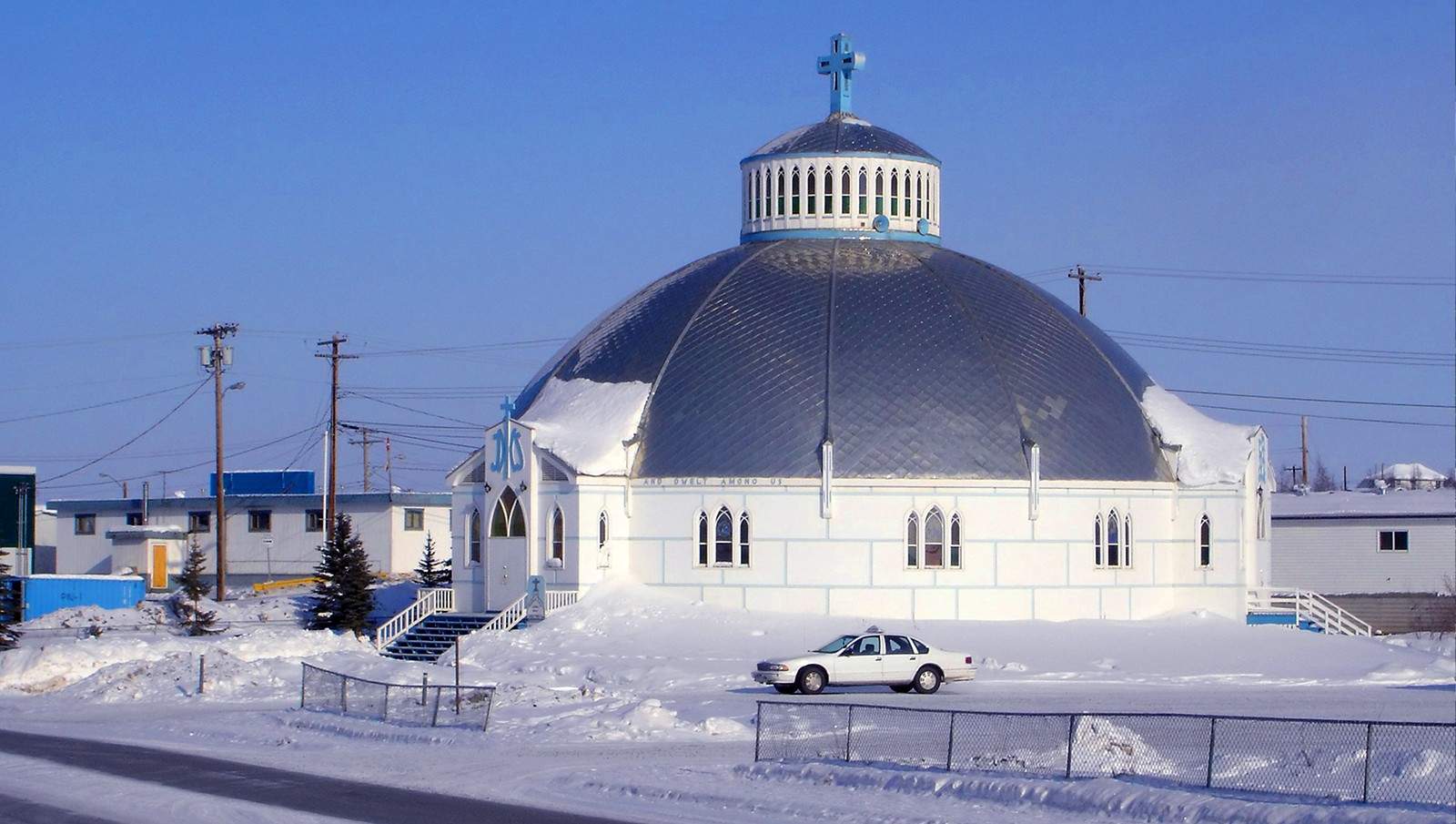
Our Lady of Victory, Igloo Church, Inuvik, Northwest Territories.
Max Lindenthaler/Shutterstock
The Northwest Territories
Though the name ends with an “s,” the Northwest Territories are now actually a single unit, the last remaining piece of Britain’s massive Rupert’s Land colony that was split into several different provinces and territories after being acquired by Canada in 1870. The modern “NWT,” as it’s casually known, is a roughly rhombus-shaped parcel of land located between the Yukon and Nunavut and contains two of Canada’s biggest lakes, Great Bear and Great Slave. Today, most NWT people, known as Northerners, live around the coast of the latter, with the capital city of Yellowknife being the largest in the territory.
After the fur trade began to fizzle and the most economically useful parts of the territory were cleaved off, the rump NWT retained a tiny population of less than 10,000 until the 1930s, when new deposits of minerals, oil and natural gas were slowly unearthed, spawning an influx of natural resource corporations and government bureaucrats. The same thing happened again in the mid-nineties, when diamonds were discovered.
Though these resource rushes created an influx of new people, industries, and jobs, swelling NWT into Canada’s largest territory with over 44,000 residents, NWT has not profited as much from its natural resource wealth as other resource-rich parts of Canada, like Alberta and Newfoundland. This was partially due to a lingering, pseudo-colonial setup in which Ottawa collected royalties on the territory’s resources, rather than the local government (see above). This system was finally abolished in 2014, and hopes are high that a new royalty regime will allow Northerners, and particularly the territory’s many aboriginal bands, to profit more directly from the resources extracted from their lands.
More About the NWT
Nunavut
The most obscure, isolated, and stereotypical of the territories, to even say “Nunavut” in Canada is to conjure an image of the most remote, exotic, backwoods part of the country. Carved from the NWT in 1999 as part of the federal government’s efforts to promote greater self-government for Canada’s northern aboriginal people, Nunavut is the only region of Canada where whites comprise less than 20 per cent of the population and over 70 per cent speak neither English or French as their first language. Traditional Inuit culture thus strongly influences all aspects of life in Nunavut to a degree that can make it seem quite aggressively “foreign” when compared to the rest of Canada, where European culture is still largely dominant.
Nunavut comprises a full fifth of the Canadian landmass and consists of two parts: a vast, but mostly uninhabitable mainland (unambiguously-named the Barren Grounds) and a massive northern archipelago of hundreds of gigantic, icy islands that reach all the way to the North Pole. On both the mainland and the islands, the few small population centres are tightly packed along the coasts. Nunavut’s largest city, Iqaluit (formerly known as Frobisher Bay), has less than 7,000 people, and most communities are generally poor and extremely rural. There are no roads connecting Nunavut cities.
As you might expect from a place that was only incorporated in 1999, much of Nunavut was created relatively recently. Many of its cities are either the outgrowth of World War II-era air force bases (as is the case with Iqaluit), or the result of Cold War-era settlement programs, when the Canadian government encouraged northerners to relocate to underpopulated parts of the territories in an effort to assert greater sovereignty over the Arctic. The territory has a small mining and fishing sector, and some small businesses to service the needs of local communities, but the vast majority of the Nunavut economy is government-run or subsidized in some way. People who live in Nunavut, known as Nunavummiut, are often forced to make expensive trips to Ontario to buy speciality goods, conduct business, or receive sophisticated medical care.
